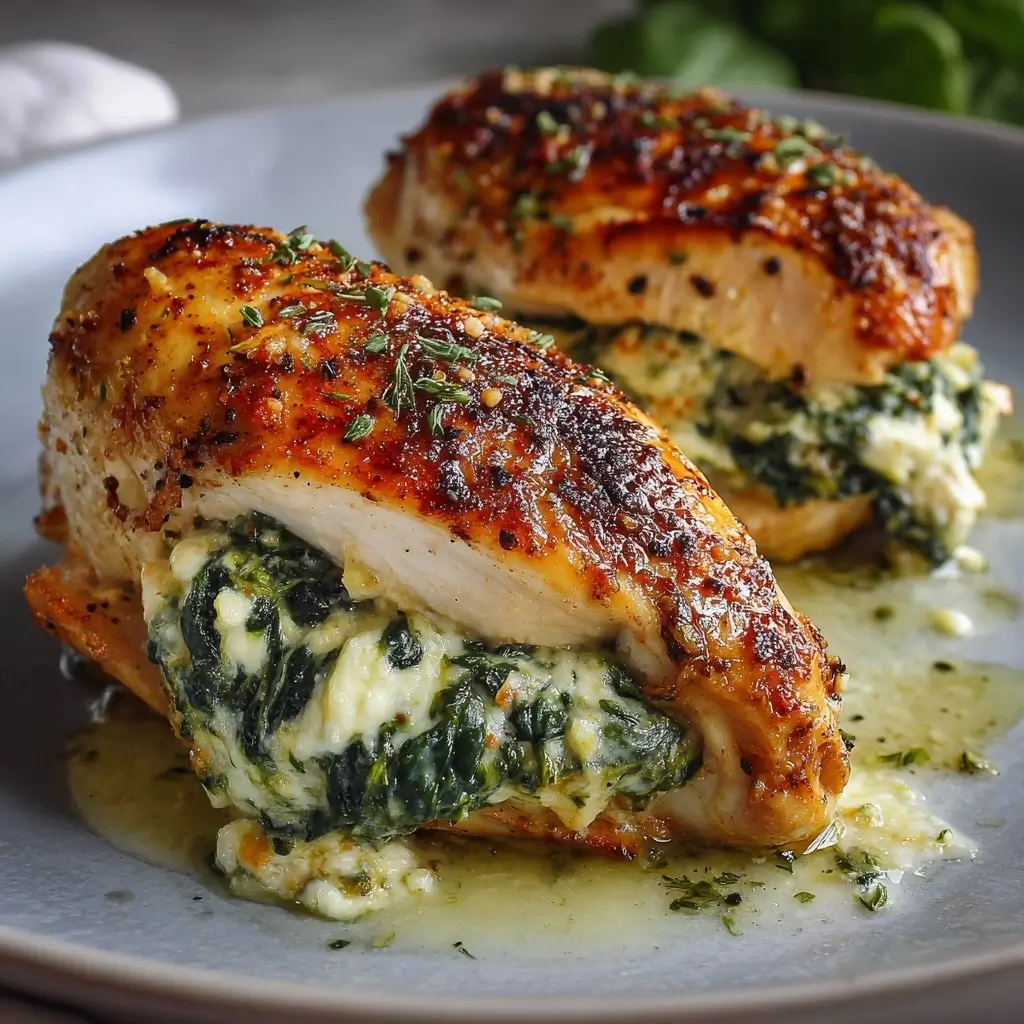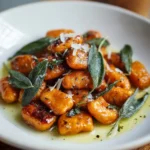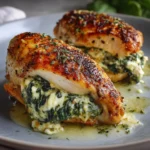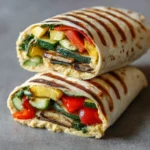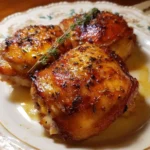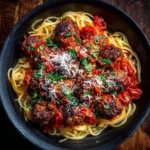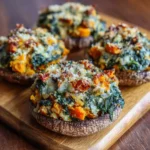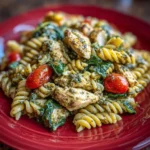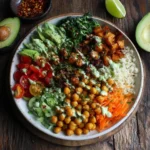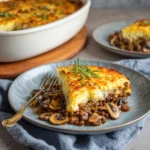Introduction
Spinach and Cheese Stuffed Chicken Breasts are a mouthwatering fusion of savory flavors, tender poultry, and nutritious greens. This elegant yet approachable dish strikes the perfect balance between comfort food and gourmet dining, making it ideal for weeknight dinners, special occasions, or impressing guests at a dinner party. With its juicy chicken exterior, creamy spinach and cheese filling, and golden-brown sear, this recipe offers a restaurant-quality experience in the comfort of your own kitchen. Whether you’re a seasoned cook or just beginning to explore more advanced culinary techniques, this stuffed chicken recipe is both satisfying and surprisingly simple to prepare.
The History
Stuffed chicken dishes have deep roots in European culinary traditions, particularly in Italian, French, and Eastern European cuisines. The practice of stuffing meats with flavorful fillings—known as “involtini” in Italy or “suppli” in some regions—dates back centuries. In Italian cooking, rolled and stuffed proteins like chicken or veal, often referred to as scaloppine ripiene, became popular during the Renaissance as chefs sought creative ways to elevate simple ingredients. Spinach and cheese combinations, especially ricotta and Parmesan, are staples in Italian dishes such as ravioli and manicotti, so it was only natural that these flavors would eventually be incorporated into poultry recipes.
In America, the popularity of stuffed chicken breasts surged in the late 20th century, thanks to the rise of home cooking shows and gourmet-inspired meal kits. Cooks began experimenting with various fillings, and the pairing of fresh spinach with melty cheeses like mozzarella, feta, or goat cheese quickly became a favorite. Today, Spinach and Cheese Stuffed Chicken Breasts are celebrated not only for their rich taste but also for their versatility and ability to blend health-conscious ingredients with indulgent flavors. This dish stands as a modern classic that bridges traditional techniques with contemporary palates.
Ingredients Breakdown
The success of Spinach and Cheese Stuffed Chicken Breasts lies in the quality and harmony of its ingredients. Each component plays a crucial role in creating a balanced, flavorful, and visually appealing dish. Here’s a detailed breakdown:
- Chicken Breasts: Boneless, skinless chicken breasts are preferred for their lean texture and ease of preparation. They provide a neutral canvas that absorbs the flavors of the stuffing and seasoning. Look for evenly sized breasts to ensure uniform cooking.
- Fresh Spinach: Fresh baby spinach is ideal because it wilts down easily and has a mild, slightly sweet flavor. It adds color, nutrients, and moisture to the stuffing. Frozen spinach can be used as a substitute, but it must be thoroughly thawed and drained to prevent a watery filling.
- Cheese: A blend of cheeses enhances both flavor and texture. Ricotta provides creaminess, while shredded mozzarella adds gooey meltability. Grated Parmesan contributes a salty, nutty depth. For a tangier profile, feta or goat cheese can be incorporated.
- Garlic: Freshly minced garlic is essential for aromatic depth. It’s sautéed briefly with the spinach to mellow its sharpness and infuse the filling with warmth.
- Onion or Shallot: Finely diced onion or shallot adds sweetness and complexity when sautéed. Shallots offer a more delicate flavor, while onions provide a bolder bite.
- Olive Oil: Used for sautéing and searing, extra virgin olive oil imparts richness and helps develop a golden crust on the chicken.
- Breadcrumbs: A small amount of breadcrumbs (plain or seasoned) can be added to the stuffing to absorb excess moisture and give the filling more structure.
- Herbs: Fresh herbs like parsley, thyme, or basil brighten the dish. Dried herbs such as oregano or Italian seasoning work well too, though fresh herbs are preferred for peak flavor.
- Salt and Pepper: Essential seasonings that enhance all other flavors. Season each layer—spinach mixture and chicken—for best results.
- Toothpicks or Kitchen Twine: Used to secure the stuffed chicken during cooking, preventing the filling from leaking out.
- Butter (optional): Adding butter during the final searing or baking stage enriches the sauce and gives the chicken a luxurious finish.
- White Wine or Chicken Broth (optional): Deglazing the pan with a splash of white wine or broth creates a simple pan sauce that elevates the entire dish.
Step-by-Step Recipe
- Prepare the Chicken: Start with 4 boneless, skinless chicken breasts. Place each breast on a cutting board and, using a sharp knife, slice horizontally through the thickest part, stopping about 1 inch before cutting all the way through. Open the breast like a book to create a pocket for stuffing. Cover with plastic wrap and gently pound to an even thickness of about ½ inch using a meat mallet or rolling pin. This ensures even cooking and makes stuffing easier.
- Make the Spinach Mixture: Heat 1 tablespoon of olive oil in a large skillet over medium heat. Add 1 finely diced shallot or small onion and sauté for 2–3 minutes until translucent. Add 2 cloves of minced garlic and cook for another 30 seconds until fragrant. Stir in 5 ounces (about 5 cups) of fresh spinach in batches, cooking until wilted and most of the liquid has evaporated, about 4–5 minutes. Remove from heat and let cool slightly.
- Combine the Filling: In a bowl, mix the cooked spinach mixture with 1 cup of ricotta cheese, ¾ cup shredded mozzarella, ¼ cup grated Parmesan, 2 tablespoons chopped fresh parsley, ½ teaspoon dried oregano, salt, and freshly ground black pepper to taste. Optional: add 2 tablespoons of breadcrumbs for a firmer texture. Stir until well combined.
- Stuff the Chicken: Spoon about ¼ of the spinach and cheese mixture into the pocket of each butterflied chicken breast. Fold the chicken over the filling and press the edges together to enclose. Secure with toothpicks or tie with kitchen twine to keep the filling intact during cooking.
- Season and Sear: Preheat oven to 375°F (190°C). Season the outside of each chicken breast generously with salt, pepper, and a pinch of paprika or garlic powder for extra flavor. Heat 1–2 tablespoons of olive oil in a large oven-safe skillet over medium-high heat. Once hot, add the chicken breasts and sear for 3–4 minutes per side, or until golden brown. Work in batches if necessary to avoid overcrowding the pan.
- Bake: Transfer the skillet to the preheated oven. Bake for 18–22 minutes, or until the internal temperature of the chicken reaches 165°F (74°C) when measured with a meat thermometer inserted into the center of the thickest part.
- Rest and Serve: Remove the chicken from the oven and let it rest for 5 minutes. This allows the juices to redistribute, ensuring moist and tender meat. Carefully remove toothpicks or twine before serving. Optionally, deglaze the pan with ½ cup of dry white wine or chicken broth, scraping up any browned bits, and simmer for 2–3 minutes to create a light sauce.
Tips
- Uniform Thickness: Pounding the chicken to an even thickness prevents overcooking one part while undercooking another. It also makes stuffing easier and promotes even searing.
- Dry Spinach: After wilting, squeeze the spinach mixture in a clean kitchen towel or paper towels to remove excess moisture. This prevents a soggy filling and helps the stuffing hold its shape.
- Don’t Overstuff: While it’s tempting to add extra filling, overfilling can cause the chicken to burst open during cooking. Aim for a generous but manageable amount.
- Use Oven-Safe Skillet: A cast-iron or stainless steel skillet that can go from stovetop to oven eliminates the need to transfer the chicken, preserving the sear and simplifying cleanup.
- Check Temperature Accurately: Insert the thermometer into the center of the chicken, avoiding the stuffing, to get an accurate reading of the meat’s doneness.
- Rest Before Slicing: Allowing the chicken to rest ensures juiciness. If you’re slicing it for presentation, wait until after resting to cut into medallions.
- Golden Crust Secret: For an extra-crispy exterior, pat the chicken dry before seasoning and searing. Moisture is the enemy of browning.
- Enhance Flavor: Marinate the chicken breasts in olive oil, lemon juice, garlic, and herbs for 30 minutes before stuffing for an extra flavor boost.
Variations and Customizations
This recipe is highly adaptable to suit different tastes, dietary needs, and ingredient availability. Here are several delicious variations:
- Mediterranean Twist: Add crumbled feta cheese, sun-dried tomatoes, Kalamata olives, and a pinch of oregano to the spinach mixture for a Greek-inspired version.
- Italian Style: Mix in chopped artichoke hearts, roasted red peppers, and marinara sauce. Top baked chicken with melted mozzarella and fresh basil for a “stuffed chicken Parm” effect.
- Low-Carb/Keto: Omit breadcrumbs and use full-fat cheeses. Serve with cauliflower mash or a crisp arugula salad.
- Creamy Mushroom Version: Replace spinach with sautéed mushrooms and caramelized onions. Use goat cheese or cream cheese for a rich, earthy flavor.
- Spicy Kick: Add a pinch of red pepper flakes or a few dashes of hot sauce to the filling. Serve with a cooling tzatziki or sour cream-based sauce.
- Dairy-Free Option: Use dairy-free ricotta and cheese alternatives, or replace cheese with mashed beans or lentils for a plant-based protein boost.
- Pesto Spin: Blend fresh basil pesto into the ricotta mixture for a vibrant, herby twist. Top with pine nuts before baking for crunch.
- Breakfast-Stuffed Chicken: Add cooked crumbled bacon or sausage and a touch of Dijon mustard to the filling for a brunch-inspired take.
- Gluten-Free: Ensure all ingredients, including breadcrumbs (if used), are certified gluten-free. Almond flour or gluten-free panko works well as a binder.
- Sheet Pan Meal: Arrange stuffed chicken on a sheet pan with vegetables like zucchini, bell peppers, and cherry tomatoes. Drizzle with olive oil and roast at 400°F for 20–25 minutes for a complete one-pan meal.
Health Considerations and Nutritional Value
Spinach and Cheese Stuffed Chicken Breasts can be a nutritious and balanced meal when prepared with mindful ingredient choices. Here’s a breakdown of the health aspects:
- High-Quality Protein: Chicken breast is an excellent source of lean protein, essential for muscle repair, immune function, and satiety. A 4-ounce serving provides about 26 grams of protein with minimal fat.
- Rich in Vitamins and Minerals: Spinach is loaded with iron, vitamin K, vitamin A, folate, and antioxidants like lutein and zeaxanthin, which support eye health and reduce inflammation.
- Calcium and Probiotics: Cheeses like ricotta and mozzarella contribute calcium for bone health. Ricotta also contains some probiotics, supporting gut health.
- Healthy Fats: Olive oil provides monounsaturated fats, which are heart-healthy and help absorb fat-soluble vitamins from spinach.
- Calorie Control: A typical serving (one stuffed breast) ranges from 350 to 450 calories, depending on cheese and oil amounts. To reduce calories, use part-skim ricotta, less cheese, or spray oil instead of pouring.
- Sodium Awareness: Cheese and seasoning can increase sodium content. Opt for low-sodium cheese and limit added salt, especially for those managing blood pressure.
- Balanced Meal Pairing: Serve with whole grains like quinoa or brown rice and a side of steamed vegetables to increase fiber and nutrient density.
- Allergen Notes: Contains dairy and eggs (in some ricotta). For egg allergies, verify cheese labels. For nut allergies, ensure no cross-contamination if using almond-based substitutes.
- Pregnancy Safety: Use pasteurized cheeses to avoid risks associated with listeria. Fully cook chicken to 165°F to ensure safety.
Overall, this dish can fit into a variety of diets—including high-protein, Mediterranean, and flexitarian—when customized appropriately.
Ingredients
- 4 boneless, skinless chicken breasts
- 1 tablespoon olive oil (plus more for searing)
- 1 small shallot or ½ small onion, finely diced
- 2 cloves garlic, minced
- 5 ounces (about 5 cups) fresh baby spinach
- 1 cup ricotta cheese (whole milk or part-skim)
- ¾ cup shredded mozzarella cheese
- ¼ cup grated Parmesan cheese
- 2 tablespoons fresh parsley, chopped
- ½ teaspoon dried oregano
- 2 tablespoons plain breadcrumbs (optional)
- Salt and freshly ground black pepper, to taste
- Optional: 1 tablespoon butter
- Optional: ½ cup dry white wine or chicken broth (for pan sauce)
- Toothpicks or kitchen twine, for securing
Directions
- Preheat oven to 375°F (190°C). Set an oven-safe skillet over medium heat.
- Butterfly each chicken breast by slicing horizontally almost all the way through, then open flat. Cover with plastic wrap and gently pound to ½-inch thickness. Season both sides with salt and pepper.
- In a skillet, heat 1 tablespoon olive oil over medium heat. Add shallot and sauté for 2–3 minutes. Add garlic and cook 30 seconds. Add spinach in batches, stirring until wilted. Remove from heat and cool slightly. Squeeze out excess moisture using a towel.
- In a bowl, combine spinach mixture, ricotta, mozzarella, Parmesan, parsley, oregano, breadcrumbs (if using), salt, and pepper. Mix well.
- Spoon about ¼ of the mixture into each chicken pocket. Fold closed and secure with toothpicks or twine.
- Heat 1–2 tablespoons olive oil in the oven-safe skillet over medium-high heat. Sear chicken for 3–4 minutes per side until golden brown.
- Transfer skillet to oven and bake for 18–22 minutes, or until internal temperature reaches 165°F.
- Remove from oven, rest for 5 minutes, then remove toothpicks or twine.
- Optional: Deglaze pan with white wine or broth, simmer 2–3 minutes to make sauce. Drizzle over chicken before serving.
FAQ
Can I prepare this dish ahead of time?
Yes! Assemble the stuffed chicken up to 24 hours in advance, cover tightly, and refrigerate. Let sit at room temperature for 15–20 minutes before cooking.
Can I freeze stuffed chicken breasts?
Yes. Freeze uncooked stuffed chicken on a tray, then transfer to a freezer bag. Cook from frozen, adding 5–10 minutes to baking time. Thawed chicken should be cooked within 1–2 days.
What if I don’t have an oven-safe skillet?
You can sear the chicken in a regular skillet, then transfer to a greased baking dish and finish in the oven.
Can I grill stuffed chicken?
Absolutely! Grill over medium heat (about 375°F) for 6–7 minutes per side, using indirect heat if flare-ups occur. Use a meat thermometer to check doneness.
Why did my chicken dry out?
Overcooking is the most common cause. Always use a meat thermometer and remove chicken at 160–163°F; residual heat will bring it to 165°F during resting.
Can I use frozen spinach?
Yes, but thaw completely and squeeze out all liquid. About 10 ounces of frozen spinach yields roughly 1 cup after cooking, equivalent to 5 ounces fresh.
Is there a vegetarian alternative?
Try stuffing portobello mushrooms or tofu steaks with the spinach-cheese mixture for a meatless version.
Summary
Spinach and Cheese Stuffed Chicken Breasts combine tender chicken, creamy ricotta, and flavorful spinach into a gourmet dish that’s surprisingly easy to make. Perfect for healthy weeknights or elegant dinners, this recipe delivers maximum flavor with minimal effort.
